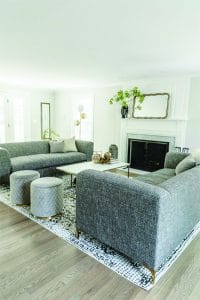Healthy Home, Happy Home
by Sarah Galluzzo
 Now that we are entertaining again, the remodeling boom has been even more significant, with some contractors booking out work six months in advance. “The demand for work is absolutely crazy. And products have been taking so much time to arrive. At times we have had to wait as long as 12 weeks for windows,” says Bill Bradsell of Bradsell Contracting in Bedford, NY.
Now that we are entertaining again, the remodeling boom has been even more significant, with some contractors booking out work six months in advance. “The demand for work is absolutely crazy. And products have been taking so much time to arrive. At times we have had to wait as long as 12 weeks for windows,” says Bill Bradsell of Bradsell Contracting in Bedford, NY.
I recently embarked upon what started as a very small “budget-conscious” remodel that evolved into a more extensive first-floor makeover. An article I read piqued my interest in learning about the harmful effects of certain home goods. The more I knew, the more I wanted to make safer, healthier choices on my remodeling and decorating projects.
Off-gassing has become a popular buzzword, but what does it mean? According to August Interiors’ founder Abigail Braden, “Some items, including candles, rugs, paints, and furnishings, can release chemicals called volatile organic compounds (VOCs) into the air.” Many particleboards, plywood furnishings, and cabinets you might find at discount stores are put together using glues made with formaldehyde, one of the hundreds of thousands of known contaminants that can impact the health of your family and pets for years. When appropriate, Braden helps her clients “upcycle” items instead of buying new, and she offers them green options for home design.
“Anytime we look at a job, we consider what the homeowners already have,” said Bradsell. “We want to use existing items and be resourceful because we don’t like to waste, and we find that we can make a project more economical and help blend new construction so it fits in and looks fresh, but not too new; to look as if it has been there for a while.”
Rae is currently helping a family build and furnish the first 100 percent sustainable LEED Certified, Passive House Certified and Net Zero home build in Ridgefield. “The homeowners are trying to limit the chemicals brought in and create a space that is as minimalist as possible,” Rae explains.
Another benefit of choosing healthier items for your home is that it doesn’t necessarily mean that you will break the bank. Kristin Crump, a designer, and owner of Fox Trot Homes, came to the trade because of personal necessity. “I moved from a small New York apartment to a 3,500 square foot home, and I needed to furnish all of that space,” she said. “I was able to find really good quality yet affordable furniture that I could refinish or restore to make my own.” Crump has created a thriving business with three CT locations, including a booth at Monger’s Market in Bridgeport.
“Monger’s Market, Restore, Facebook Marketplace, and tag sales have become treasure troves for thrifty people. Beautiful older items can be repurposed using just a little creativity and some elbow grease. It’s good to cherry-pick what you want from estate sales,” Crump explains. If you are overwhelmed by the idea of restoring a piece, you can take a class from Crump or another pro to learn how to refinish it. But even if you don’t have the time or inclination to refinish things, you can still save by going to places like Habitat for Humanity Restore. For example, you can buy discarded high-quality kitchen cabinets and then ask your contractor to paint or refinish them. “It’s an excellent way to get a high-end kitchen cabinet at the cost you might pay for kitchen cabinets made from lower-quality materials,” Crump says.
But not everyone thinks this way; the disposable mindset of many consumers exacerbates the lack of sustainability. “Our landfills are filling up with valuable items that could be refurbished and reused for another 100 years,” Crump says. By choosing new items that are often shipped from overseas, consumers buy products that have caused a more significant carbon footprint, are usually made with VOCs and other chemicals, and are of a much lower quality than older items.
When considering more ways to save, it’s important to keep in mind that minor changes can make a big impact. “Creating a healthier home doesn’t have to be a huge expense,” said Rae. “Air quality is a number one concern. You can bring aesthetically pleasing house plants indoors to naturally cleanse the air, purchase inexpensive air purifiers, declutter your space and remove knick-knacks to maintain a cleaner, more minimalistic home.”
Whether you are a DIY designer or working with a licensed professional, before making any decisions on home design, think green. “It may sound cliché, but a healthier home is a happier home,’ says Rae. “Make every room a sanctuary, and try to declutter and destress to create cleaner, healthier spaces.”